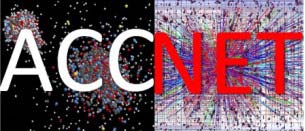NETWORK STRUCTURE |
The network is divided in three tasks. Three
coordinators (W.Scandale, A.Variola, F.Zimmermann) are the responsible for the management task
that coordinates the whole Accnet activities. The other two tasks take into
account the development of new proposal and design to optimize the LHC
performances (Eurolumi) and the development and synergies in RadioFrequency
technology projects.

PARTICIPATING INSTITUTES and LINK PERSONS
Task 1. AccNet
Coordination and communication
The activities of this task are to oversee and
coordinate the EuroLumi and RFTECH networks between them and with all other
relevant Work Packages in EuCARD, to ensure the
consistency of the WP work according to the project plan and allocate and
control network budgets. The coordination duties also include the organization
of AccNet internal steering meetings, the setting up of proper reviewing, the
reporting to the project management, the contribution to the Annual Meetings
and the distribution of the information within AccNet as well as to the other
work-packages running in parallel. The task also covers the organization of
and/or support to activity workshops or specialized working sessions, implying the
attendance of invited participants from inside and outside the consortium.
Task 2.
EuroLumi
EuroLumi is the European forum for discussing performance limitations of high-intensity high-brightness accelerators, with emphasis on hadron facilities. It will help analyze and optimize the proposed upgrades of these facilities, and will also explore advanced future schemes such as proton driven plasma acceleration and medical applications of accelerators.
In particular,
EuroLumi will coordinate and integrate
the activities of the accelerator and particle physics communities towards realizing the full potential of the LHC,
by means of LHC luminosity upgrades and new
or enhanced LHC injectors. Several scenarios for increasing the LHC
performance by at least an order of magnitude were developed in the FP6 CARE-HHH
network. They all combine an upgrade of the two high-luminosity interaction
regions (IRs), with modified beam parameters, and with an enhanced
higher-brightness injector complex. EuroLumi will create strong synergies by
also supporting the SLS upgrade
and the FAIR project at GSI,
another major hadron facility in Europe.
Taking into account the results of CARE-HHH and
interfacing with the US-LARP
programme, the EuroLumi network will be the
European forum for discussing performance limitations of high-intensity
high-brightness hadron accelerators, and
for analyzing and optimizing the proposed upgrade paths of these
facilities. EuroLumi will bring together experts in beam dynamics with specialists of magnets and collimation
to arrive at optimum upgrade solutions with minimum risk. EuroLumi will also
help guiding the FP7 CNI for the LHC interaction region upgrade. Calculations
performed within EuroLumi can be benchmarked via beam experiments at the operating
LHC, as well as at PS, SPS, RHIC, Tevatron , or DAFNE. EuroLumi will integrate the efforts
of the large laboratories, smaller institutes and universities, and it will
form and maintain a community capable of advancing the technical realization
& scientific exploitation of the European hadron facilities.
The following institutes have expressed
interest in the EuroLumi activities: BINP (RU), BNL (USA), Bologna U (IT), CERN
(International Organization), CI (UK), CINVESTAV (Mexico), CNRS-LAL (FR),
CNRS-LPSC (FRS), CSIC-IFIC (ES), DESY (DE) , FNAL (USA), GSI (DE), IHEP (RU), INFN–LNF (IT),
INFN-NA (IT), JINR (RU), KEK (JP), RCC KI (RU), LBNL (USA),
MPP (DE), RHUL (UK), Sannio University (IT), SLAC (USA),
STFC (UK), TEMF (DE),
Texas A&M (USA), TU Berlin (DE),
Task 3.
RFTECH:
Exploitation of synergy on developments of high and low power RF systems for
new accelerator projects
RFTECH will coordinate and integrate
the European development of radiofrequency (RF) technology for future particle
accelerators and associated research infrastructures, in a worldwide context.
RFTECH encompasses all aspects of RF technology, e.g. klystron development, RF
power distribution system, cavity design, and low-level RF system, for linear
accelerators and storage rings, including transversely deflecting (crab)
cavities and financial aspects such as costing tools.
The following institutes have expressed
interest in the RFTECH activities: BNL (USA), CEA-DSM (FR), CERN (International
Organization), CI (UK), CNRS-LPNHEP (FR), CNRS-LPSC (FR), DESY (DE) , FNAL
(USA), GSI (DE), INFN –LNF (IT), JLAB (USA), KEK (JP), LBNL (USA), IFJ PAN
(PO), SLAC (USA), STFC (UK), TEMF (DE),
THALES (FR),
TSDA (DE), TU Berlin (DE),
TUL (PO), UJF (FR),
UOM (M), UPSA (SE),
UROS (DE),
WUT (PO).
Back to
AccNet web site

